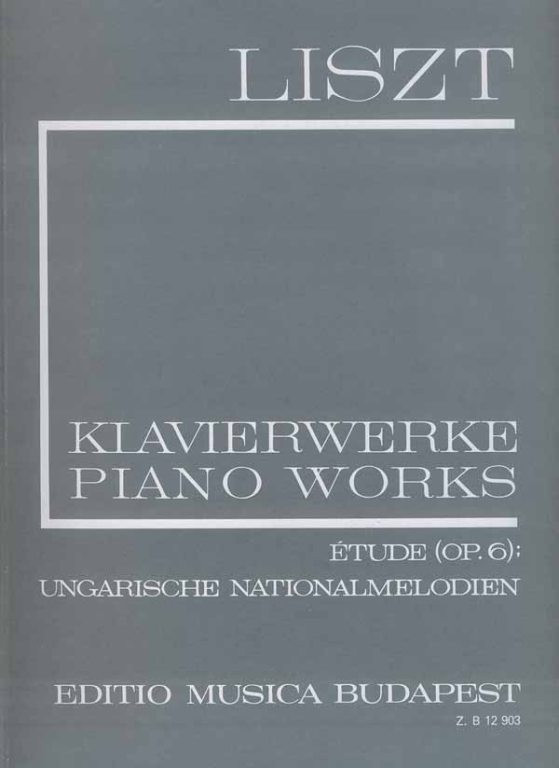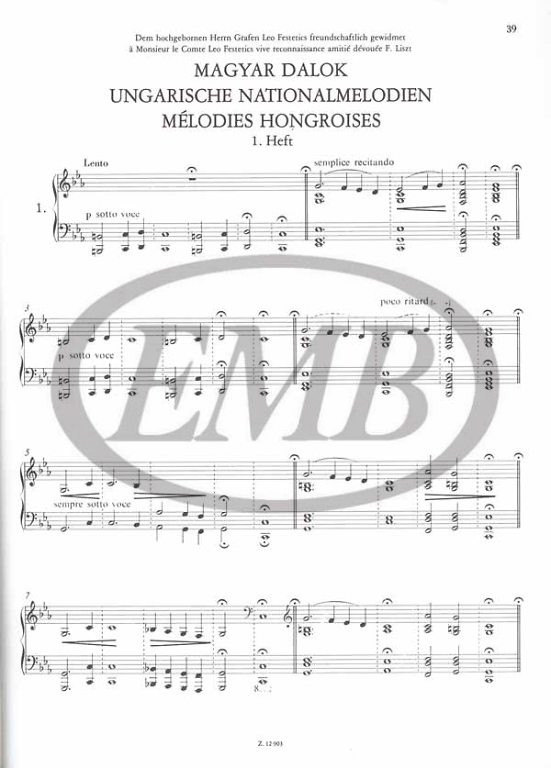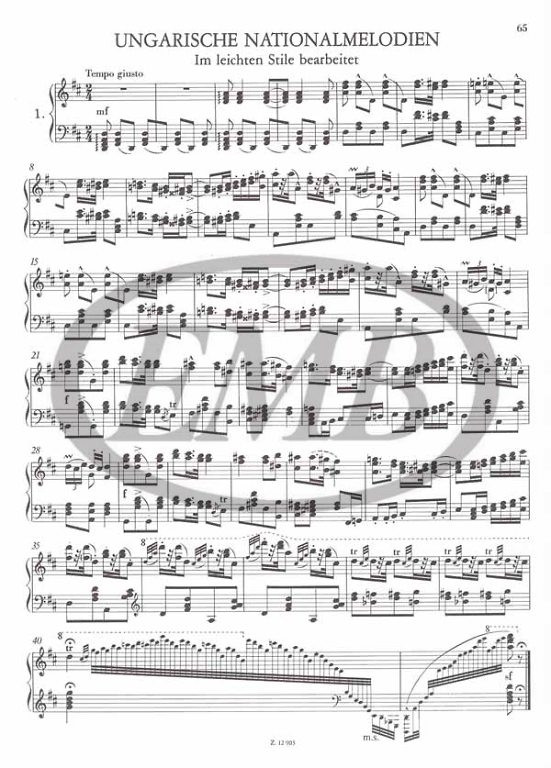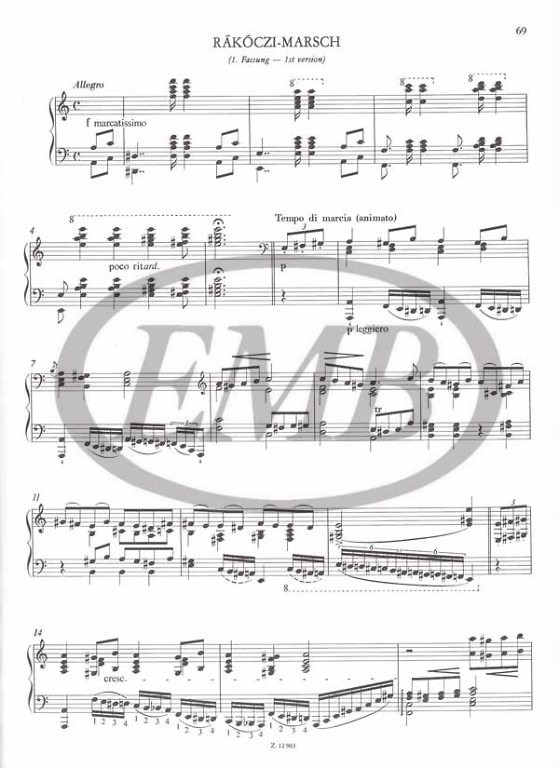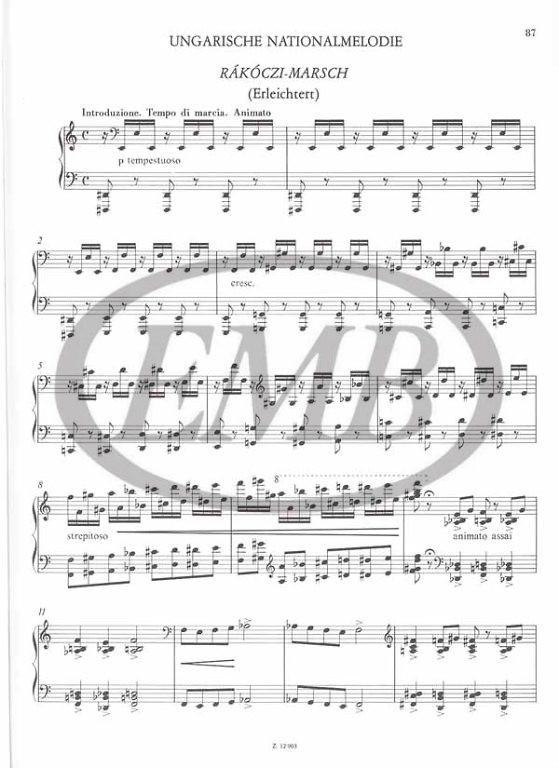Description
Liszt Ferenc: Étude en douze exercices (Op. 6), Ungarische Nationalmelodien, Buch der Lieder II (I/18) / Edited by Sulyok Imre, Mező Imre / Editio Musica Budapest Zeneműkiadó / 1985 / Közreadta Sulyok Imre, Mező Imre
Paperback
Made in Hungary
Setting: Piano
Series: New Liszt Edition I. 'B'
Genre: Complete Edition
Period: Romantic
Language: English, German
Length: 232 pages
Format: 23 x 30 cm
Weight: 0.843 kg
Published: 1985
Publisher: Editio Musica Budapest Zeneműkiadó
Item number: 12903
ISMN: 9790080129036 / 979-0080129036
Hangszer/letét: Zongora
Sorozat: Liszt Ferenc összes műveinek új kiadása I. (karton) 'B'
Műfaj: Összkiadás
Korszak: Romantikus
Nyelv: angol, német
Terjedelem: 232 oldal
Formátum: 23 x 30 cm
Súly: 0,843 kg
Első megjelenés: 1985
Kiadó: Editio Musica Budapest Zeneműkiadó
Katalógusszám: 12903
The last volume of Series I of the New Liszt Edition contains etudes, Hungarian-style pieces and piano transcriptions of songs. Liszt probably composed the pieces Op. 6 Étude en douze exercices in 1826, when he was 15 years old. These later gave rise to the series of Transcendental Etudes (included in volume Z. 5411). At the turn of 1839/40 Liszt arrived in Hungary for the first time as a famous pianist. Then, and again when he visited later in 1846, he had the opportunity to hear Gypsy musicians, whose playing influenced him greatly. In this period Liszt wrote arrangements of many Hungarian melodies, and these provided the raw material for the later series of Hungarian Rhapsodies. This volume includes the early rhapsodies containing thematic material not found in the final versions. One interesting feature of this volume is that it presents six versions of the Rákóczi March. Concluding the volume there are the piano transcriptions of six songs composed to poems by Victor Hugo.
As customary, there are two versions of the publication: a blue clothbound edition and a grey softcover edition. The informative preface giving the most important information on the contents and technical details is identical in both versions, but only the former version includes an English description of the sources and a critical commentary. Both versions include facsimiles of pages of Liszt's original autograph manuscript.
Az Új Liszt-Összkiadás I. sorozatának utolsó kötete etűdöket, magyaros darabokat és dalok zongoraátiratait tartalmazza. Az Op. 6-os Étude en douze exercices darabjait Liszt valószínűleg 1826-ban, 15 éves korában komponálta. Ezekből született meg később a Transzcendes etűdök sorozat (ezeket a Z. 5411 kiadvány közli). Liszt 1839/40 fordulóján érkezett Magyarországra először mint elismert művész. Ekkor, és későbbi, 1846-os látogatásakor lehetősége volt cigány muzsikusokat hallani, akiknek játéka nagy hatással volt rá. Liszt ebben az időszakban számos feldolgozást írt magyar dallamokra, amelyek előzményül szolgáltak a későbbi Magyar rapszódiák sorozathoz. Ebben a kötetben azok a korai rapszódiák kaptak helyet, melyekben olyan tematikus anyag is megtalálható, mely a végleges változatokba nem került bele. Érdekessége a kiadványnak, hogy a Rákóczi-induló hat változatát is bemutatja. A kötetet végül hat, Viktor Hugo verseire komponált dal zongoraátirata zárja.
A kiadvány két változata az eddigiek szerint kék vászonkötésben és szürke kartonkötésben jelent meg. A művekről a legfontosabb tartalmi és technikai tudnivalókat ismertető angol és német nyelvű előszó mindkét változatban azonos, míg az angol nyelvű forrásleírásokat és kritikai megjegyzéseket csak az előbbi változat tartalmazza. A kötet elején mindkét változatban Liszt eredeti kéziratlapjainak hasonmásai láthatók.
Contents / Tartalomjegyzék
|
1. |
Étude en douze exercices (Op. 6) 1. (C-dúr - C major - C-Dur) R. 1 G. 136 |
|
|
|
2. |
Étude en douze exercices (Op. 6) 2. (a-moll - A minor - a-Moll) R. 1 G. 136 |
|
|
|
3. |
Étude en douze exercices (Op. 6) 3. (F-dúr - F major - F-Dur) R. 1 G. 136 |
|
|
|
4. |
Étude en douze exercices (Op. 6) 4. (d-moll - D minor - d-Moll) R. 1 G. 136 |
|
|
|
5. |
Étude en douze exercices (Op. 6) 5. (B-dúr - B-flat major - B-Dur) R. 1 G. 136 |
|
|
|
6. |
Étude en douze exercices (Op. 6) 6. (g-moll - G minor - g-Moll) R. 1 G. 136 |
|
|
|
7. |
Étude en douze exercices (Op. 6) 7. (Esz-dúr - E-flat major - Esz-Dur) R. 1 G. 136 |
|
|
|
8. |
Étude en douze exercices (Op. 6) 8. (c-moll - C minor - c-Moll) R. 1 G. 136 |
|
|
|
9. |
Étude en douze exercices (Op. 6) 9. (Asz-dúr - A-flat major - As-Dur) R. 1 G. 136 |
|
|
|
10. |
Étude en douze exercices (Op. 6) 10. (f-moll - F minor - f-Moll) R. 1 G. 136 |
|
|
|
11. |
Étude en douze exercices (Op. 6) 11. (Desz-dúr - D-flat major - Des-Dur) R. 1 G. 136 |
|
|
|
12. |
Étude en douze exercices (Op. 6) 12. (b-moll - B-flat minor - b-Moll) R. 1 G. 136 |
|
|
|
13. |
Magyar dalok - Ungarische Nationalmelodien 1. Lento R. 105/a G. 242 |
|
|
|
14. |
Magyar dalok - Ungarische Nationalmelodien 2. Andantino R. 105/a G. 242 |
|
|
|
15. |
Magyar dalok - Ungarische Nationalmelodien 3. Sehr langsam R. 105/a G. 242 |
|
|
|
16. |
Magyar dalok - Ungarische Nationalmelodien 8. Lento; Tempo marcato R. 105/a G. 242 |
|
|
|
17. |
Magyar dalok - Ungarische Nationalmelodien 9. Lento; Quasi presto R. 105/a G. 242 |
|
|
|
18. |
Magyar dalok - Ungarische Nationalmelodien 10. Adagio sostenuto a capriccio; Allegro vivace R. 105/a G. 242 |
|
|
|
19. |
Ungarische Nationalmelodien. Im leichten Stile bearbeitet 1. Tempo giusto R. 105/d G. 243 |
|
|
|
20. |
Ungarische Nationalmelodien. Im leichten Stile bearbeitet 2. Animato R. 105/d G. 243 |
|
|
|
21. |
Ungarische Nationalmelodien. Im leichten Stile bearbeitet 3. Prélude; Allegretto R. 105/d G. 243 |
|
|
|
22. |
Rákóczi-Marsch (1. változat - 1st version - 1. Fassung) * R ľ G. ľ |
|
|
|
23. |
Ungarische Rhapsodien - Magyar rapszódiák - Rapsodies hongroises 13. (Rákóczi-Marsch) R. 105/b G. 242 |
|
|
|
24. |
Ungarische Nationalmelodie. (Rákóczi-Marsch) Erleichtert R. (105) G. ľ |
|
|
|
25. |
Marche de Rákóczi. Édition populaire R. (105) |
|
|
|
26. |
Rákóczi-Marsch nach der Orchesterbearbeitung für das Pianoforte R. 106/15b G. 244/15 |
|
|
|
27. |
Rákóczi-Marsch nach der Orchesterbearbeitung für Pianoforte erleichtert R. (106/15/b) G. ľ |
|
|
|
28. |
Ungarische Rhapsodien - Magyar rapszódiák - Rapsodies hongroises 15. Lento; Vivace R. 105/b-c G. 242 |
|
|
|
29. |
Ungarische Rhapsodien - Magyar rapszódiák - Rapsodies hongroises 17. Andante sostenuto; Friss, Vivace R. 105/b-c G. 242 |
|
|
|
30. |
Ungarische Rhapsodien - Magyar rapszódiák - Rapsodies hongroises 20. Allegro vivace; Andante R. 105/b-c G. 242 |
|
|
|
31. |
Buch der Lieder für Piano allein - Band II * Poésies lyriques pour piano seul * 1. Oh, quand je dors * R. 210 G. 536 |
|
|
|
32. |
Buch der Lieder für Piano allein - Band II * Poésies lyriques pour piano seul * 2. Comment, disaient-ils * R. 204 G. 535 |
|
|
|
33. |
Buch der Lieder für Piano allein - Band II * Poésies lyriques pour piano seul * 3. Enfant, si j'étais roi * R. 205 G. 537 |
|
|
|
34. |
Buch der Lieder für Piano allein - Band II * Poésies lyriques pour piano seul * 4. S'il est un charmant gazon * R. 206 G. 538 |
|
|
|
35. |
Buch der Lieder für Piano allein - Band II * Poésies lyriques pour piano seul * 5. La tombe et la rose * R. 207 G. 539 |
|
|
|
36. |
Buch der Lieder für Piano allein - Band II * Poésies lyriques pour piano seul * 6. Gastibelza * R. 208 G. 540 |
